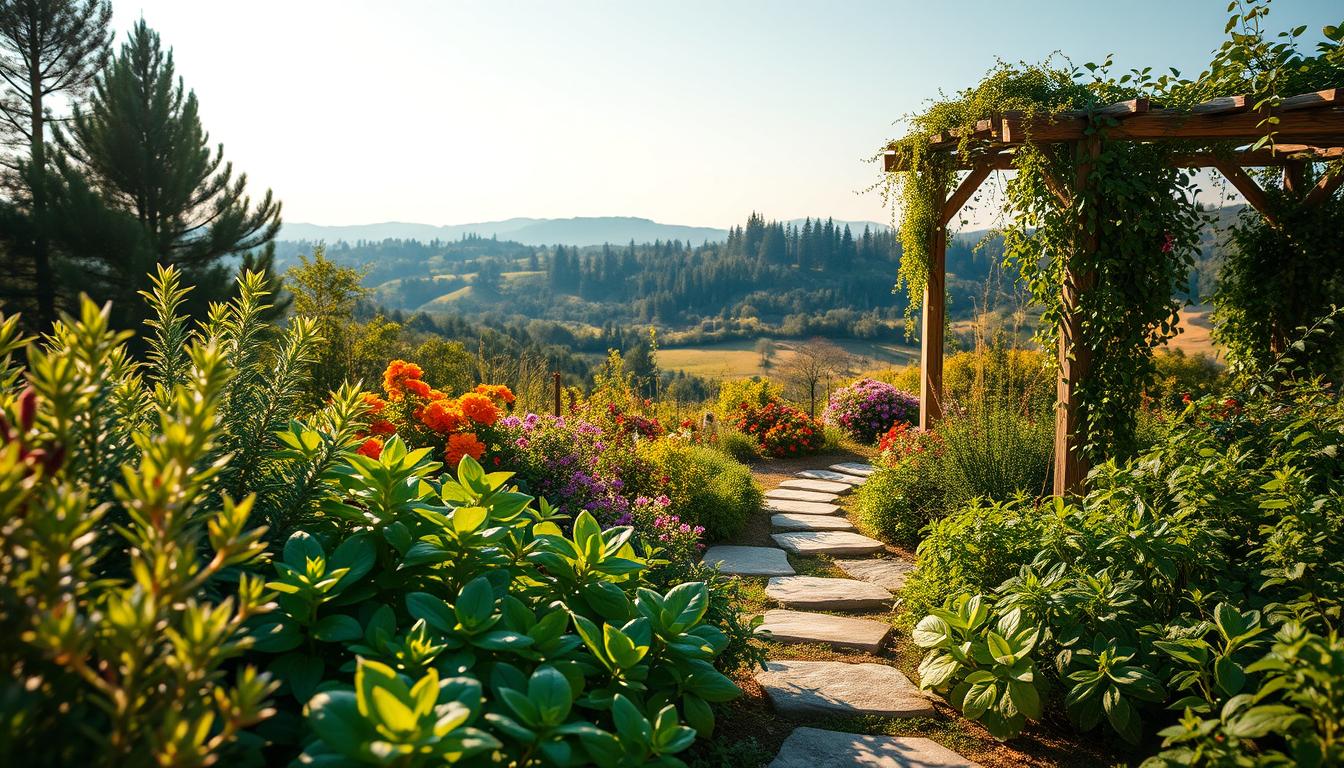Are you ready to make your outdoor space smell amazing and be super useful? Imagine picking fresh herbs right from your backyard for your next meal. It’s like turning every dish into a work of art.
I love growing herbs and I’ve learned that even tiny spots can become lush green havens. Whether you have a small balcony or a big backyard, these 25 ideas will help you create a beautiful and useful outdoor space.
With a little creativity, any area can become a lush green spot. You’ll learn how to use every inch of your outdoor space with these smart tips. From hanging gardens to pots, the options are endless!
Key Takeaways
- Herb gardens can dramatically enhance outdoor living spaces
- Small spaces can be transformed into productive green areas
- Vertical gardening techniques maximize limited space
- Herbs provide both culinary and aesthetic benefits
- Creative container solutions make herb gardening accessible to everyone
Why Create an Herb Garden?
Turning your outdoor space into a vibrant herb garden opens up new culinary and wellness options. With 80% of people believing it makes cooking better, growing herbs is more than a hobby—it’s a lifestyle.
Building an outdoor herb garden design brings many benefits beyond just looks. Here’s why you might want to try it:
- Fresh flavor enhancement for home-cooked meals
- Reduced grocery expenses
- Natural stress relief through gardening activities
- Potential health and medicinal benefits
Benefits of Growing Herbs
The best herbs to grow in a garden do more than just taste good. Gardening can cut stress by 36%, making it a calming activity. Many herbs also boost health, like improving immunity and digestion.
Enhancing Your Cooking Experience
Imagine picking fresh herbs right before cooking. With 90% of home gardeners using more herbs when they’re easy to get, an herb garden changes how you cook. Fresh herbs add depth and complexity that dried herbs can’t.
Growing your own herbs isn’t just about food—it’s about creating an experience.
Whether you have a big backyard or a small balcony, you can create an herb garden. The start-up costs are low, from $50 to $150. It’s a rewarding project for garden lovers of all levels.
Choosing the Right Location
Starting a small space herb garden begins with picking the right spot. The garden’s success depends on good placement for sunlight and easy access. Knowing how to design your outdoor herb garden is key to a lush space.
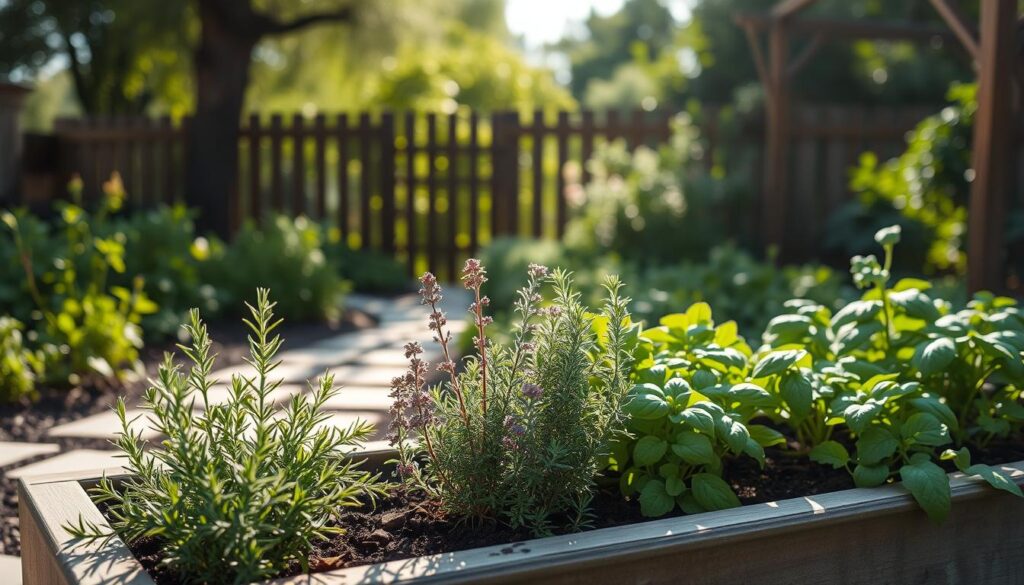
- Assess available sunlight throughout the day
- Evaluate proximity to your kitchen
- Determine drainage and soil conditions
- Consider wind protection
Sunlight Requirements
Most herbs need at least 6 hours of direct sunlight every day. Watch your outdoor area to find spots that get the sun right. South-facing spots usually get the most sunlight for gardens.
Accessibility Considerations
Choosing the right spot is key for a small herb garden. Put your garden where you can easily pick and care for your plants. A good spot is near your kitchen door or on a sunny balcony.
Pro tip: Vertical gardening techniques can maximize limited spaces while keeping your herbs within arm’s reach.
Your outdoor herb garden design should be both useful and pretty. With the right planning, even tiny areas can become green and lovely herb spots.
Selecting Your Favorite Herbs
Starting an aromatic herb garden is a fun journey into flavors and creativity. Whether you love cooking or gardening, picking the right herbs can make your outdoor space lively and tasty. Let me show you some top herbs to grow that will make your garden and cooking better.
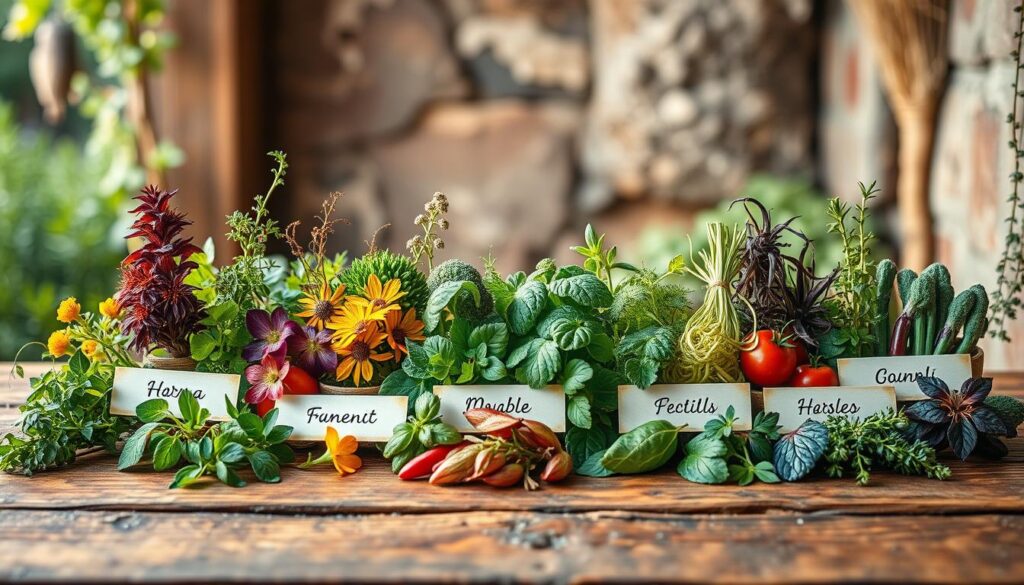
Choosing herbs is more than picking pretty plants. Start with a mix of classic and unique herbs. They will add flavor to your cooking and beauty to your garden. Here are some essential herbs to have:
- Basil: A versatile herb perfect for Italian and Thai cuisines
- Rosemary: A robust herb with woody flavors ideal for roasted meats
- Thyme: Excellent for Mediterranean dishes
- Oregano: A staple in pizza and pasta recipes
Unique Herb Varieties to Explore
For something special in your garden, try these unique herbs:
- Lemon Verbena: Brings citrusy notes to teas and desserts
- Chocolate Mint: A surprising herb with rich, sweet undertones
- Pineapple Sage: Offers a tropical twist to traditional herb collections
“The secret to a great herb garden is variety and creativity!” – Herb Gardening Enthuasiast
Think about your cooking style, space, and sunlight when picking herbs. Some love full sun, others prefer shade. By choosing wisely, you’ll have a garden that looks great and tastes amazing.
Designing Your Herb Garden Layout
Creating the perfect outdoor herb garden design needs careful planning and creativity. My love for gardening shows me that the right layout can make even small spaces bloom. Whether you have a big backyard or a tiny balcony, there are many ways to create your own herb haven.

When thinking about your vertical herb garden, start by looking at your space and sunlight. I suggest trying out different layouts to make the most of your space:
- Raised beds for better soil control
- Ground planting for saving money
- Vertical gardening to save space
Raised Beds: A Gardener’s Best Friend
Raised beds are great for herb lovers. They help with drainage, prevent soil from getting too dense, and let you create the best growing spot. My top garden design tips include using wooden or stone beds. They make your garden look good and work well.
Vertical Gardening Solutions
Vertical herb gardens are perfect for small spaces. Imagine turning a blank wall into a living herb display! You can use hanging planters, pallet gardens, or tiered shelves to make any small area green and lush. Herbs like thyme, rosemary, and mint do well in vertical gardens.
Pro tip: Mix and match different herbs to create a visually stunning and functional vertical garden that saves space and looks incredible.
Companion Planting with Herbs
Creating a thriving DIY herb garden is more than just placing plants together. Companion planting is a smart way to make your herb garden a harmonious place. Here, plants help and improve each other’s growth.
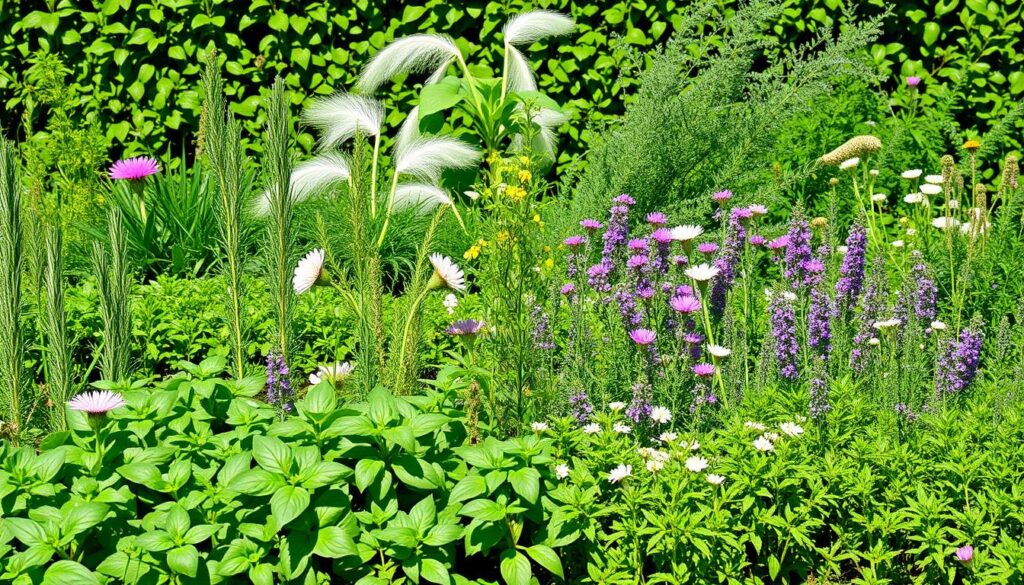
Companion planting is a top herb gardening tip for a better garden. Knowing which herbs go well together helps make your garden more productive and strong.
Friends and Foes in the Garden
Not all herbs get along. Some can slow down each other’s growth, while others work together well. Here are some important pairs to think about:
- Basil: Great for tomatoes, keeps pests away, and makes flavors better
- Rosemary: Keeps harmful insects away from other plants
- Mint: Draws good insects but should be in pots to stop it from spreading
“In nature, plants are not solitary beings but part of a complex, interconnected ecosystem.” – Garden Wisdom
Enhancing Growth with Companion Herbs
Smart herb gardening tips can make your plants healthier and more productive. Studies show that companion planting can increase herb yields by up to 20%. Some amazing pairs include:
- Chamomile near mint to boost essential oil production
- Parsley alongside asparagus to improve growth
- Thyme near cabbage to deter harmful insects
By using these companion planting strategies, your DIY herb garden will not only look great. It will also create a self-sustaining environment where plants help each other.
Container Herb Gardens
Turning small spaces into lush herb gardens is now easy with container herb garden ideas. As an urban gardener, I’ve found that small space herb gardening lets anyone grow fresh herbs, even with little outdoor space. Creative gardening solutions can make even the smallest balcony or windowsill into a thriving herb garden.
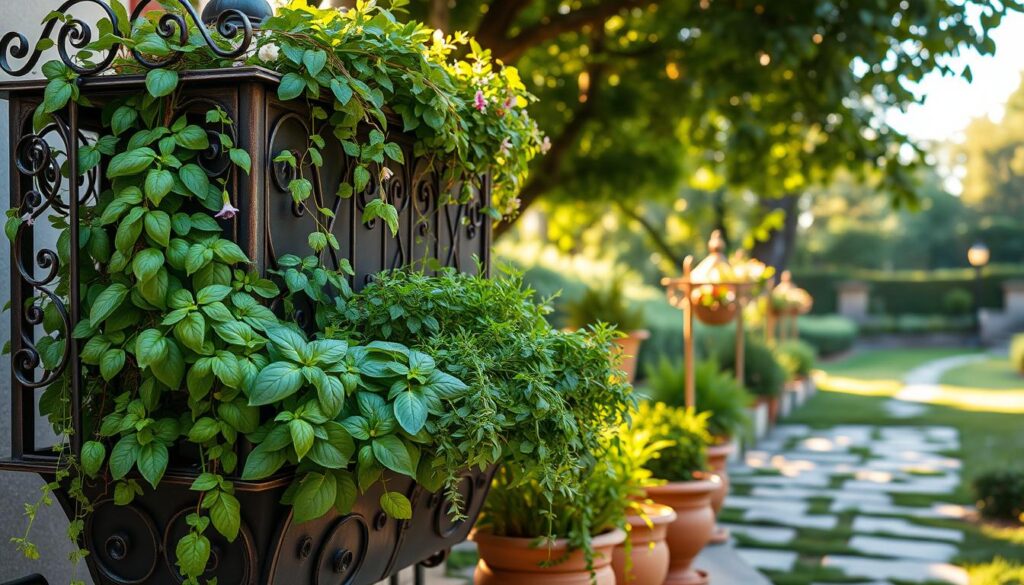
Choosing the right containers is key for growing herbs well. Terra cotta pots are a favorite because they let air in and prevent waterlogging. Pro tip: Make sure your containers have drainage holes to keep your herbs healthy.
Best Containers for Your Herb Garden
- Terra cotta pots for excellent air circulation
- Hanging baskets for vertical gardening
- Recycled containers for eco-friendly options
- Ceramic planters with modern design
Benefits of Container Gardening
Container gardening is super flexible for herb lovers. You can grow up to eight different herbs in a small space. Favorites include:
- Rosemary
- Basil
- Thyme
- Oregano
- Mint
The filler, spiller, thriller method makes your container garden look great and healthy. Mediterranean herbs like lavender and rosemary do well in containers. They need little water and love well-draining soil.
Whether you live in the city or suburbs, container herb gardens are a fun way to grow your own herbs. Start small, try different containers, and watch your garden grow!
Herb Garden Themes
Turning your outdoor herb garden into a work of art is possible with unique themes. These themes show off your personal style. Most gardeners, 75%, like custom designs over the usual layouts.
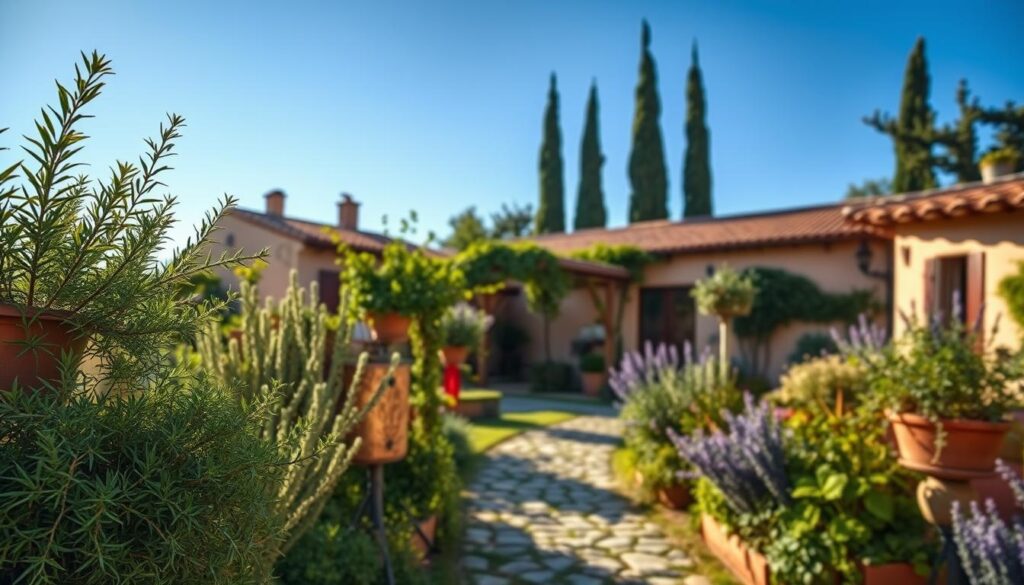
Mediterranean-Inspired Herb Gardens
A Mediterranean-inspired garden feels like a trip to sunny places. To get this look, focus on these tips:
- Use terra cotta pots for an authentic feel
- Select drought-resistant herbs like rosemary, thyme, and oregano
- Incorporate gravel pathways to mimic Mediterranean terrain
- Plant herbs in clusters for a natural, wild appearance
Charming Cottage-Style Herb Gardens
Cottage gardens mix beauty with usefulness. They often have a mix of flowers and herbs, with 60% of gardeners using at least three types of herbs.
- Mix herbs with colorful flowers for visual interest
- Use rustic trellises and wooden fencing
- Create informal, overlapping planting arrangements
- Combine edible and ornamental plants for maximum impact
Whether you prefer the neat Mediterranean style or the playful cottage look, your garden can be a special place. It shows off your unique gardening style.
Vertical Herb Gardens
Small space herb gardening has changed how city gardeners grow fresh herbs. Turning blank walls into green spaces with aromatic plants is inspiring. These solutions make the most of every inch, turning small areas into green oases.
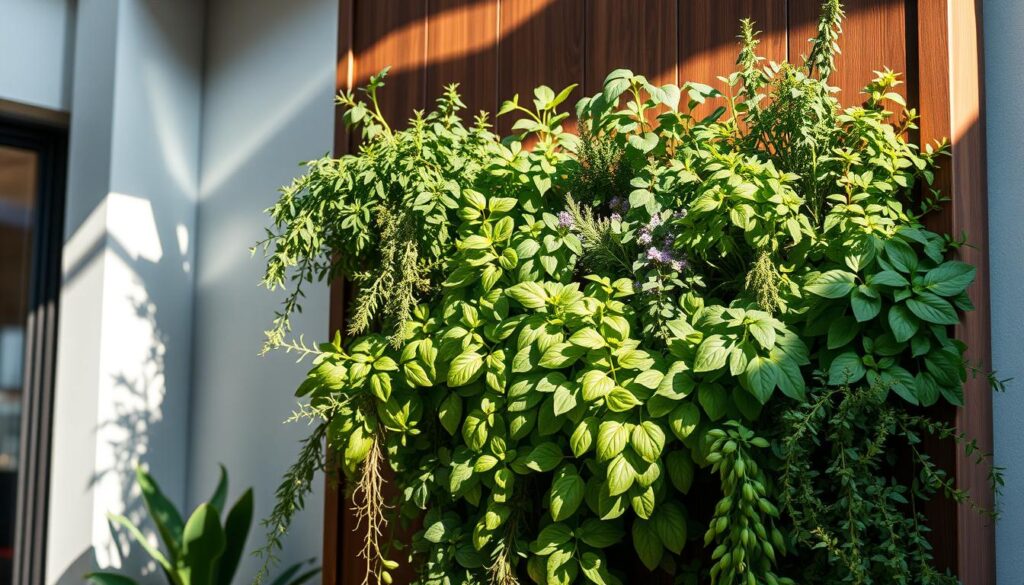
Starting a vertical herb garden is exciting for home cooks and garden lovers. I’ve found clever ways to grow herbs in tight spots:
- Repurpose over-the-door shoe organizers as herb planters
- Mount wooden pallets on walls for a rustic vertical garden
- Use hanging mason jars for individual herb sections
- Install wall-mounted pocket planters for multiple herbs
Innovative Wall Space Solutions
Turning vertical surfaces into gardens needs creativity and planning. Choose herbs that do well in small spaces, like:
- Basil – compact and quick-growing
- Thyme – tolerates tight spaces
- Mint – spreads easily in vertical arrangements
- Rosemary – provides beautiful vertical structure
Creative Vertical Planter Ideas
Your vertical herb garden can be a beautiful feature. Look at these planter options that are both functional and stylish:
- Geometric wall-mounted metal planters
- Recycled tin can arrangements
- Hanging macramé plant holders
- Modular ceramic wall systems
Pro tip: Make sure your vertical garden gets enough sunlight and has good drainage. This keeps your herbs healthy and growing well.
Seasonal Herb Gardening Tips
Herb gardening is all about knowing when to plant. My DIY herb garden journey showed me how important timing is. It’s key to growing these tasty plants.
Spring is the best time to start your herb garden. You have about 6 months to make it grow well.
Spring Planting Strategies
Here are some key spring planting tips:
- Start seeds indoors 6-8 weeks before the last frost
- Choose herbs that do well in your area
- Use good potting soil for healthy plants
- Make sure herbs get 6-8 hours of sun a day
Preparing for Winter Harvests
Winter doesn’t mean your herb garden has to stop. Here are ways to keep growing herbs:
- Pick cold-hardy herbs like thyme and oregano
- Use cold frames to keep plants safe
- Grow herbs indoors near sunny windows
- Harvest and save herbs before the first frost
Herb gardening is all about adjusting to the seasons. With these tips, you can have fresh herbs all year in your DIY garden.
Maintaining Your Herb Garden
To have a thriving DIY herb garden, you need to care for it regularly. It’s important to know what each plant needs. Then, create a plan to keep your herbs healthy and growing well.
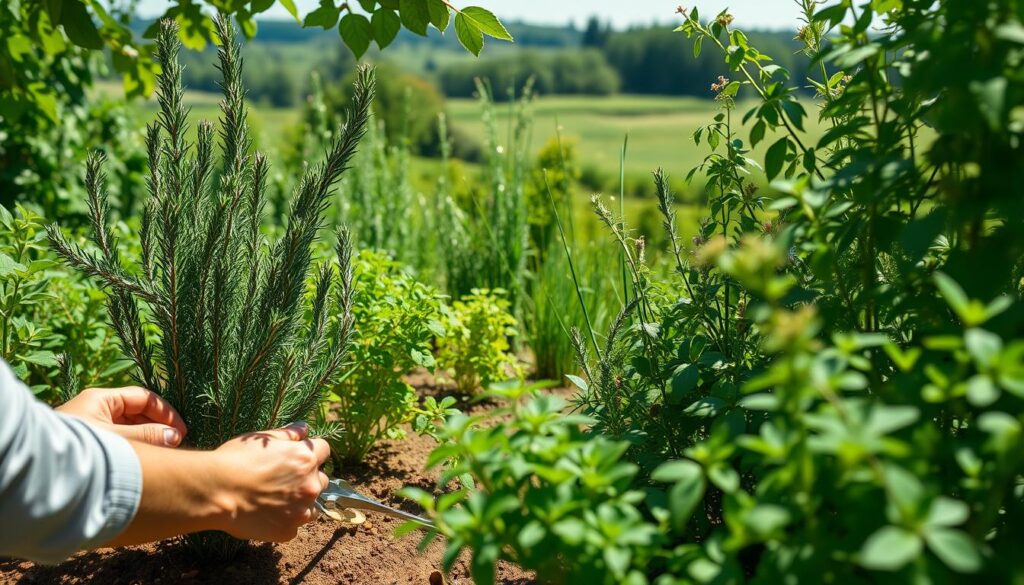
Watering is key to a successful herb garden. Each herb needs different amounts of water. Leafy herbs like basil and mint need more water than woody herbs like rosemary and thyme.
Watering Strategies for Healthy Herbs
- Check soil moisture before watering
- Water deeply but infrequently
- Use room temperature water
- Avoid overwatering to prevent root rot
Fertilization and Nutrition
Herbs need the right nutrients to grow well. Use organic, slow-release fertilizers every few weeks. This keeps your herbs healthy and flavorful.
Pruning and Harvesting Techniques
Pruning keeps your herbs bushy and healthy. Cut them back before they flower. Harvest in the morning for the best flavor.
A well-maintained herb garden not only provides fresh ingredients but also transforms your outdoor space into a vibrant, aromatic sanctuary.
Exploring Herb Garden Accessories
Creating a stunning DIY herb garden is more than just planting herbs. The right accessories can make your outdoor garden go from simple to spectacular. These additions make gardening fun and efficient.
Essential tools are key to a successful herb garden. I suggest getting high-quality pruning shears, a precise watering can, and durable gloves. A wooden wall planter, costing under $10 and taking less than an hour to make, adds vertical interest. Rolling cart herb gardens also offer mobility to get the most sunlight for your herbs.
DIY markers can really personalize your garden. I enjoy making unique herb labels with air-dry clay or using vintage items like old ladders and chicken feeders. Modern ceramic planters and vinyl labels add style and functionality to your garden.
Choosing the right accessories boosts your garden’s productivity and shows off your personal style. Whether you’re an experienced gardener or just starting, these thoughtful touches will make your herb garden special.
Source Links
- https://www.southernliving.com/small-backyard-ideas-6536191?srsltid=AfmBOopIPVP7U7nJ_GPt4dmGO3GYE33SJAy4_t6unLHmtzQqUcsIy4yf – 25 Small Backyard Ideas For Creating A Mini Outdoor Oasis
- https://doraihome.com/blogs/news/backyard-oasis-ideas-to-create-a-dreamy-outdoor-space?srsltid=AfmBOopP66ZmVkhVtwo16BEtyWgq0AT7nA4eOohLUlOhkcgbBlOSM4uL – 21 Backyard Oasis Ideas: Create A Dreamy Outdoor Space | Dorai Home
- https://www.aol.com/25-budget-small-garden-ideas-214945466.html – 25 Budget Small Garden Ideas for a Gorgeous Yet Affordable Yard
- https://www.thegardenglove.com/insanely-cool-herb-garden-container-ideas/ – Insanely Cool Herb Garden Container Ideas
- https://stacyling.com/beginners-guide-to-growing-an-herb-garden-step-by-step-tips-for-success/ – How to Grow an Herb Garden: A Step-by-Step Guide
- https://www.ashlinakaposta.com/blog/outdoor-herb-garden-ideas – 11 IDEAS THAT WILL INSPIRE YOU TO FINALLY START YOUR OUTDOOR HERB GARDEN — ASHLINA KAPOSTA
- https://www.arkaenergy.com/learn/backyard-garden-ideas?srsltid=AfmBOopWCDNI2vKvRU-vw07QclWsLiea433UeehU5b8_GIyMhssm8fkv – 21 Functional and Beautiful Backyard Garden Ideas [2025]
- https://gloverlandscapes.com/blog/backyard-botanical-garden-oasis/ – 10 Ideas For Creating A Backyard Botanical Garden Oasis
- https://www.hello-hayley.com/herb-garden-ideas/ – 38 Unique Herb Garden Ideas for Indoor and Outdoor Spaces
- https://ecoscape.co.uk/advice/an-introduction-to-growing-herbs-on-your-deck/ – An Introduction To Growing Herbs On Your Deck | Ecoscape
- https://www.greenwashingindex.com/stunning-raised-bed-garden-layouts/ – 15 Stunning Raised Bed Garden Layouts That Will Transform Your Backyard!
- https://www.southernliving.com/small-backyard-ideas-6536191?srsltid=AfmBOord3F2OAHUQjvmZXFNf-SEdApMaLDoMGSF3uolg5HzBAFl6oYEz – 25 Small Backyard Ideas For Creating A Mini Outdoor Oasis
- https://www.arkaenergy.com/learn/backyard-garden-ideas?srsltid=AfmBOop3OCwUaDl4IzPY_Wjsu2KcMFeSXvtD4pi8KNIPsgc1EAuaVVFG – 21 Functional and Beautiful Backyard Garden Ideas [2025]
- https://www.countryliving.com/gardening/garden-ideas/g4098/best-plants-for-container-gardening/ – Our Top 55 Container Gardening Ideas Will Bring So Much Charm to Your Porch or Patio
- https://www.sowinginsuburbia.com/blog/edible-landscape – 25 Plants for Edible Landscaping: Grow Food Beyond the Backyard — Sowing in Suburbia
- https://www.marthastewart.com/1145807/creative-container-garden-ideas – 25 Creative Container Garden Ideas to Enhance Porches, Patios, and Other Outdoor Spaces
- https://www.southernliving.com/container-gardens-6541696?srsltid=AfmBOorc57Ch8Sf1Nd7vFWpwTgSR70QfO43dVti2OHBb0RoT9bNopgyF – 114 Of Our Best Container Gardening Ideas
- https://www.frenchpetalgardens.com/garden-theme-ideas/ – 12 Creative Garden Theme Ideas: Transform Your Outdoor Space
- https://www.southernliving.com/small-backyard-ideas-6536191?srsltid=AfmBOopkpy1L9AzBtXFKVhj9ZdAeKKlntRGyZspQJ13DDlfKGuYT91UP – 25 Small Backyard Ideas For Creating A Mini Outdoor Oasis
- https://www.thespruce.com/5-unique-ideas-for-a-hanging-garden-5080070 – 31 Vertical Garden Ideas and Designs
- https://www.goodhousekeeping.com/home/gardening/g40736540/vertical-garden-ideas/ – Here’s How to Use an Old Shoe Organizer to Showcase Your Succulents
- https://www.stonegableblog.com/planting-herbs-raised-beds/ – Planting Herbs In Raised Bed Gardens
- https://mylifeabundant.com/growing-herbs-indoors/ – Growing Herbs Indoors & Herb Butter
- https://florasense.com/blogs/how-to-start-a-balcony-herb-garden/ – Flora | How to Start a Balcony Herb Garden
- https://www.arkaenergy.com/learn/backyard-garden-ideas?srsltid=AfmBOoq5FpARCDi_SilDywkWRhbRJ0ZeCvffTLKmdznc1hUNu45uwKBj – 21 Functional and Beautiful Backyard Garden Ideas [2025]
- https://www.yahoo.com/lifestyle/creative-diy-herb-garden-ideas-205000917.html – These Creative DIY Herb Garden Ideas Will Have You Cooking in No Time
